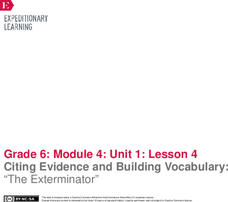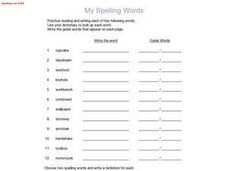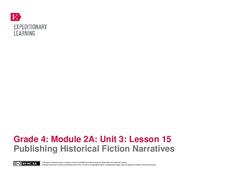Shodor Education Foundation
Pythagorean Explorer
Make sure the measurement is right. The interactive provides right triangles with a missing side measurement. Pupils use the given sides and the Pythagorean Theorem to calculate the length of the missing side. After entering the length,...
Southern Poverty Law Center
Evaluating Online Sources
All sources are pretty much the same, right? If this is how your class views the sources they use for writing or research projects, present them with a media literacy lesson on smart source evaluation. Groups examine several articles,...
EngageNY
Citing Evidence and Building Vocabulary: “The Exterminator”
It is an out-of-body experience. Scholars take a look at the sidebars outside the body of the text in The Exterminator. They discuss the purpose of this type of text feature and work to determine the gist. Learners write unfamiliar...
It's About Time
Making Waves
Young scientists use Slinkys to better understand waves. After creating and measuring many aspects of waves, they complete a handout and homework questions. The resource also introduces the final project for the chapter, though...
Curated OER
Dialect
With a list of popular British slang words, this learning exercise prompts pupils to define their colloquialisms as if they were in the dictionary. Because the words are so specifically regional, American learners might not recognize...
Curated OER
Split Suffixes
Make new words by adding suffixes to word beginnings. There are four suffixes here: -ible, -able, -ive, and -ion. After using them to complete five given words, they use their vocabulary skills to apply the suffixes to...
Curated OER
Analogies
Middle schoolers answer seven analogy questions using their problem solving and vocabulary skills to discover how various words are related. Pupils are encouraged to use a dictionary as needed.
Curated OER
Vocabulary Building Through Visualization of Word Meanings to Create Digital Art
Use online dictionaries to define vocabulary words and create a visualization of word meanings through digital art. Middle schoolers go online to define assigned vocabulary words. They visualize the meanings of the words in photo...
Curated OER
Vocab-u-lous! Build a Fabulous Vocab
In this vocabulary worksheet, students decipher the best word choice to complete the sentence. All words use Y as a vowel to build a fabulous vocabulary.
Curated OER
The Mouse and the Motorcycle
Students follow along as they read chapters in the book The Mouse and the Motorcycle. They work with a partner and choose 5 objects to measure when the class does the measuring activity. Students make a picture dictionary using at...
Curated OER
Nutrition Dictionary Worksheet
In this vocabulary worksheet, 7th graders use words associated with nutrition. Students respond to 10 words, looking each up in the dictionary and writing one fact that they have learned about each specific word.
Curated OER
Abridged and Unabridged Dictionaries
Young scholars perform research into the history and formation of the English Language. The use of multiple types of activities is used for application of the theory of Multiple Intelligences.
Curated OER
My Spelling Words: Spelling List #186
Learning to use the dictionary is a long-term investment in good spelling. scholars practice writing compound nouns, look them up in the dictionary, and write the guide words from the dictionary page where they were found. I'd extend it...
Global Oneness Project
The Importance of Indigenous Language Revitalization
Middle schoolers consider languages as representations of cultures and the importance of preserving various languages, especially the rapidly disappearing languages of indigenous peoples, in a lesson that tells the story of Marie Wilcox...
Curated OER
Understanding Core Values Using the Frayer Model
Students complete the Frayer Model. In this literature lesson, students review the concept of theme in literature. Students identify major themes in books they've read. Students learn the attributes of the Frayer Model and then complete...
Curated OER
Understanding and Using Primary and Secondary Sources in History
Explore primary and secondary sources in this historical analysis lesson. Young researchers define the terms primary source and secondary source. They read a primary source document provided by the teacher and answer questions about...
Scholastic
Study Jams! The Kingdoms of Life
Life science learners discuss the characteristics of five kingdoms of life: animals, plants, fungi, protists, and bacteria in this video. Viewers find out from the dialogue that scientists group organisms according to similarities. This...
EngageNY
Publishing Historical Fiction Narratives
Class members discover what it means to publish their works. Working on a computer, young writers use an online dictionary to edit their spellings and conventions based on the information added to the rubric. From here, and most of the...
Penguin Books
A Teacher’s Guide to the Signet Classic Edition of George Orwell’s 1984
Whether you're new to using Nineteen Eighty Four in the classroom or you're an Orwell veteran, the materials in this teacher's guide are a valuable addition to your curriculum. The suggested activities prompt readers to create a newspeak...
EngageNY
Close Reading: Louie’s Change of Heart
Scholars read additional pages in Unbroken to discover more about Louie's character. Readers use turn-and-talk strategies to discuss character traits that describe Louie. They then answer text-dependent questions and cite evidence to...
EngageNY
Launching The Performance Task: Building Background Knowledge: “War in the Pacific,” Part 1
It's all about a bit of give and take. Scholars silently read War in the Pacific and circle any unfamiliar words. Using context clues, they write each word on a strip of paper along with the inferred definition. After looking the word up...
EngageNY
Key Incidents Reveal Aspects of Character: Survival at Sea (Pages 114-168)
Learn from experience. As part of their study of Unbroken, scholars use a turn-and-talk strategy to discuss Louie's experiences and the presence of God while he is lost at sea. They then read quotes from the text and infer what the words...
Novelinks
The Tempest: A-Z Book Project
Create a picture dictionary for one of William Shakespeare's most famous plays. After readers finish The Tempest, they assign each letter of the alphabet to a concept or character, and add a description and evidence from...
Harper Collins
The Giving Tree Anniversary Teaching Guide
Celebrate poetry month all of April with a guide that uses six of Shel Silverstein's most famous books as a basis for the lessons. Discussion questions and writing activities are provided for each of Silverstein's books.
Other popular searches
- How to Use a Dictionary
- Dictionary Use Guide Words
- English Dictionary Use
- Unabridged Dictionary Use
- Lessons on Dictionary Use
- Dictionary Use Research
- How to Use a Dictionary Skills
- How to Use the Dictionary
- How to Use Dictionary
- Strategies for Dictionary Use
- Use a Dictionary

























